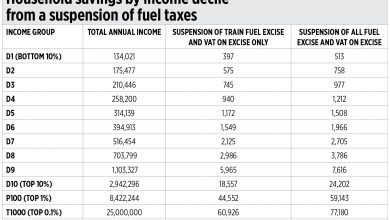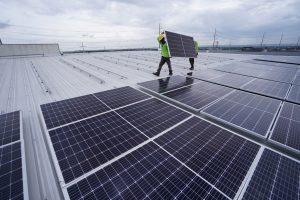Mainstreaming inflation and the Fund

Mainstreaming some economic ideas becomes easier when enough focus is dedicated to it during the Annual Meetings of the International Monetary Fund (IMF) and the World Bank Group. After years of absence, for instance, inflation took center stage again during this April’s hybrid Spring Meetings. Fund economists behind the World Economic Outlook (WEO) have started talking about it and raising the red flags to global growth because of price pressures building up both in the US and big markets, and in small developing and emerging markets.
For instance, the IMF’s Chief Economist Pierre-Olivier Gourinchas in his press briefing on the latest WEO last Tuesday argued that the world’s economic prospects have been severely undermined as inflation may prove to be more long lasting due to Russia’s invasion of Ukraine. This is enough for the Fund to downgrade its projection of global growth from January’s 4.4% to this month’s 3.6%.
All that the Fund is saying is that Ukraine is the wild card. The continued hostilities fuel the series of supply shocks that propagate spillovers to the global economy through commodity markets, trade and financial linkages. With reduced supplies from Russia and Ukraine, oil, gas, metals, wheat, and corn prices are bound to escalate and magnify price pressures on other commodities and services.
The timing of the war in Eastern Europe could not have been worse. The pandemic has hardly disappeared from the scene while supply-demand imbalances continue to rage, prompting monetary policy normalization. With supply bottlenecks already pushing inflation higher, the latest China lockdowns could add yet another supply shock.
The Fund therefore identified monetary tightening and financial market volatility as one of the principal forces shaping near-term global outlook namely, the Russia-Ukraine war, fiscal withdrawal, slowing growth in China, and the pandemic and vaccine access.
For these reasons, the Fund has declared that “inflation has become a clear and present danger for many countries.”
Gourinchas noted that inflation has reached its highest level in over 40 years in the United States and some European countries given their tightening labor markets. This is just the inflation level, but what should also worry us is its expected long duration.
The Fund correctly identified the risk of a possible de-anchoring of inflation expectations away from central bank inflation targets. Some central banks have actually begun tightening their monetary stance; others decided to wait for more signs of second-round effects. The problem with being patient nowadays is that price movements have been unprecedentedly sharp, especially for food and fuel. This could easily build up into social unrest and destabilization.
If this rising inflation is not arrested promptly, we might be seeing spillovers into the global financial markets, tightening of financial conditions, and ultimately, from the perspective of smaller economies, capital flight. We don’t have to complete the analytical loop but we can almost foresee what comes next in terms of currency depreciation, trade disruption, and still higher inflation, and then weaker growth.
Looking back, the concern about this rising inflation originated from former US Treasury Secretary Larry Summers in a Washington Post column in Feb. 2021. He questioned the enormous size of US President Joseph R. Biden’s $1.9-trillion pandemic response which passed through the US Congress. He predicted then: “There is a chance that macroeconomic stimulus on a scale closer to World War II levels than normal recession levels will set off inflationary pressures of a kind we have not seen in a generation.” US inflation then stood below 2%. In March this year, inflation averaged 8.54 %.
Today, people are disputing whether Summers’s analysis is consistent with what is unravelling. As John Cassidy in The New Yorker of April 8 clarified, while Summers stressed the expansionary role of Biden’s American Rescue Plan and the US Fed that seems to be behind the curve in raising its policy rate early enough, others put weight on the pandemic impact on global supply chains and the labor market. Following this argument, some wonder why some European economies that eschewed big pandemic packages are also going through inflation of historic proportions.
If this analysis is to be followed, we must be seeing a global phenomenon that is gaining momentum from factors other than pandemic-driven fiscal support. US economists’ assessment that does not derive from Summers’, points to the prolonged Delta and Omicron variants and their impact on supply chains and the labor market. Most importantly, US administration economists are questioning Summers’ statistics. They argued that the estimated output gap was much larger than what was assumed by the Congressional Budget Office and the actual amount of public spending stood so much less than what was assumed by the former US treasury secretary. Therefore, with a bigger output gap and lower actual public spending, the budget allocation should not be too inflationary.
But Summers was quick to point out that the US nominal GDP is double digit and with some capacity constraints, inflation could only be excessive. He also cited a study by the Federal Reserve Bank of San Francisco showing that with a large stimulus budget including for cash transfer, that could have contributed at least three percentage points to inflation by the fourth quarter of 2021. On the smaller size of actual public spending, Summers countered: “If the argument is that the money has not yet been spent, that makes the stimulus even more problematic because it’s going to be coming at a time when there is overheating.”
His central point is that demand has been high relative to potential supply. If the two cannot be balanced and inflation starts heating up, macroeconomic management must have failed.
For Summers, it is important that the US Fed bite the bullet and sharply increase its policy rate. He is for prompt monetary action against the threat of inflation. While some Democrats have observed Summers could be providing too much ammunition to the Republicans, he has this to say: “The benefits from the American Rescue Plan depend on a strong economy, which is threatened as overheating leads to declining real wages and, quite possibly, recession.”
Two other important points are prominent in the analysis of Summers. The enormous pandemic plan has crowded out desirable long-term investments in what the US calls “Build Back Better” Plan. In the Philippines, this could be a good return to a more efficient and effective execution of Public-Private Partnerships.
His other point is that inflation at all costs should be considered a grave threat to be managed well. Otherwise, even progressive politics could be at risk. Closer at home, international financial institutions like the IMF, World Bank, ADB, and the ASEAN +3 Monitoring and Research Office are all one in saying the Philippine economy could grow by about 6% in 2022 and pre-pandemic levels could be regained in a couple of years. Yet, monetary policy appears timid even as official forecasts already indicate elevated inflation for the rest of the year in excess of the target. Next year’s inflation is expected to start tapering. A preemptive, nominal adjustment could have a big meaningful guidance to the market that inflation is a concern and monetary policy remains cautiously pro-active to re-anchor inflation expectations close to the targets.
Back to the Fund.
In the April WEO, the Fund was unequivocal that inflation drivers could be diverse, and in many cases, beyond monetary control. But it has been observed that price pressures are increasingly becoming more broad-based. The impact of the Ukraine war could also vary across countries depending on their trade and financial linkages.
Like a referee, the Fund prescribes that whether inflation is driven by strong fiscal policy support, as Summers would put it, or motivated by fuel- and war-related commodity price pressures, the Fund believes that “tighter monetary policy will be appropriate to check the cycle of higher prices driving up wages and inflation expectations, and wages and inflation expectations driving up prices.”
By all means, we must avoid this cycle in the Philippines.
Diwa C. Guinigundo is the former deputy governor for the Monetary and Economics Sector, the Bangko Sentral ng Pilipinas (BSP). He served the BSP for 41 years. In 2001-2003, he was alternate executive director at the International Monetary Fund in Washington, DC. He is the senior pastor of the Fullness of Christ International Ministries in Mandaluyong.




